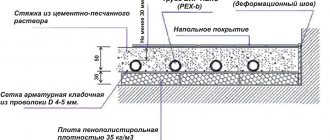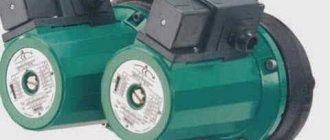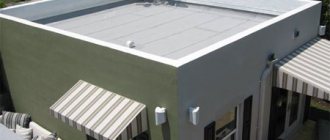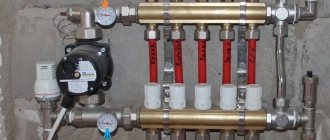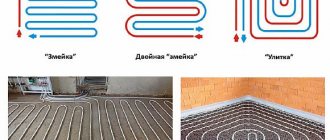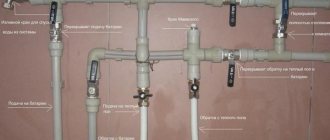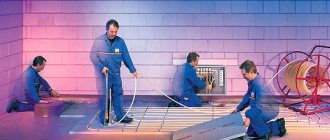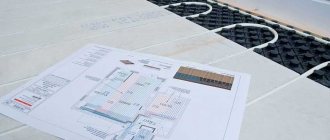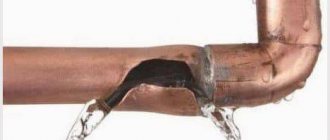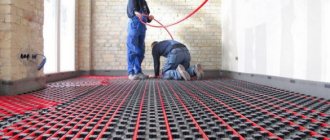The need for waterproofing
Everything is quite obvious here. Such a measure will direct heat upward, preventing it from passing through the ceilings. Quite often, many people forget about installing waterproofing under a warm water floor, but its necessity is explained by several reasons:
- It is imperative to install waterproofing under a warm water floor, since leaks in the pipes in which the coolant moves can cause damage to the base. And if the apartment is not located on the first floor, the neighbors living below you will suffer from the flood;
- Under water and electric floors, a waterproofing layer is necessary to separate the insulating material from the concrete floor. Changes in temperature and cold emanating from the base will cause condensation to appear, negatively affecting the layer of insulating material;
- in rooms on the first floor or located on the ground, it is recommended to lay waterproofing between the ground and the screed to create protection from capillary moisture. The second solution to the problem is to lay waterproofing between the insulation layer and the rough screed.
When using insulation material that is vulnerable to water from any side, experts advise laying it between two waterproofing layers in the following situations:
- The underfloor heating system is being installed, but there is a possibility of leaks;
- the installation of the floor is carried out using the wet method, and the insulation must be protected from the water that is in the solution;
- the floor is installed in a bathroom or other room with high humidity, and there is a possibility of water penetrating through the floor coverings.
As a rule, in underfloor heating systems, the underlay acts as a waterproofing layer for the insulation on top. For example, foamed polyethylene with a foil surface is responsible for reducing heat loss, uniformity of its distribution, and protects the insulating layer from moisture.
Many people are interested in whether waterproofing is necessary under a heated floor in principle, and whether in wet rooms there is a need to lay waterproofing on top of a heated floor - corrosion can begin from water leaks, and in the case of an electrical system there is a possibility of a short circuit.
Such worries are groundless, since heating elements and coolant pipes are created in such a way that they can be mounted under a screed, which creates an aggressive environment before final drying.
Cable and electrical underfloor heating systems, like water-based ones, have their own waterproofing, so the penetration of moisture from above does not pose a threat to them.
Waterproofing roof insulation
Pitched roofs
So, in the under-roof space, the rolled material is mounted above the thermal insulation with the water-repellent side up. This helps prevent the migration of moisture that gets under the roof covering during rain or when snow melts. The liquid may also condense, which is commonly seen with metal roofs. The moisture accumulated on the film or membrane flows down to the gutters or evaporates.
The installation differences between conventional films and “breathing” membranes are dictated by their structural properties. The membranes have a semi-permeable structure, retaining liquid from above, but allowing vapor to pass freely from below. Therefore, they can be laid directly on the insulation without leaving a gap for ventilation. Under the films, on the contrary, a ventilation gap is necessarily created, under which an additional counter batten is mounted.
Flat roofs
It is often reasonable to replace waterproofing under insulation in flat roof or attic structures with a vapor barrier. In this case, film materials or coating technologies are used. Water protection must be carried out from the outer surface of the thermal barrier, for which it is covered with a screed, which is given hydrophobic properties. For example, Kalmatron brand compositions can be used for this.
The use of the drug "Kalmatron-D" is recommended at the stage of laying the screed, and the finished coating can be treated with mixtures of "Kalmatron", "Kolmatex" or others from this series. The compositions strengthen the screed, block the penetration of moisture, but do not interfere with the movement of steam. They are designed specifically for waterproofing work on concrete surfaces of underground and above-ground structures. Such treatment increases the frost resistance of concrete to at least F 300, and water resistance by at least 4 levels.
Criteria for selecting waterproofing materials
According to the specific application, such materials are divided into different types, but their selection is subject to the same requirements:
- atomosphere resistance - protection from moisture must be distinguished by the ability to retain its original properties and quality characteristics for the longest possible period;
- moisture resistance and resistance to water is a very important criterion that determines the ability not to let or absorb water;
- chemical resistance - this parameter is important in order to avoid damage from exposure to chemical elements during operation;
- resistance to temperature changes - this property helps to maintain original performance at certain temperatures;
- biological stability - this characteristic allows you to prevent the penetration and impact of bacteria and microorganisms on the structure of the waterproofing material.
When deciding which waterproofing material to use for underfloor heating, it is recommended to pay attention to the following important aspects:
- price. As a rule, rolled materials are cheaper. Mastic materials and primers are more expensive, but provide better protection from moisture;
- features of the premises - for rooms with a small area it is better to use mastic, but large rooms are easier to cover with roll materials;
- the possibility of installing waterproofing on your own - it is easiest to work with impregnating compounds, but difficulties may arise with the deposited layer.
In most cases, manufacturers of underfloor heating systems recommend types of waterproofing materials as recommendations. These include:
- polyethylene and polyvinyl chloride film materials. They are equipped with thermo-reflective layers. For ease of installation, the edges are heated and joined, insulation is performed with adhesive flax;
- cement-polymer - a freshly prepared elastic composition is applied to the surface using a roller or spatula, and a special tape is laid at the joints. The result is a durable and waterproof coating that is excellent for concrete surfaces. Many note its elasticity, which is very important during changes in temperature conditions and shrinkage of buildings recently put into operation;
- cast - the most reliable option. Today, liquid silicone membranes are used for this purpose, creating good adhesion and being elastic.
Liquid silicone membranes - a type of waterproofing for underfloor heating
Why is floor insulation necessary?
To create a comfortable floor surface temperature; To save energy.
You can carry out floor thermal insulation work with your own hands. The first step is to choose the insulation material that best suits your needs.
1. Mineral wool is used for floor insulation - it is a fairly reliable and popular material. Roll material, which is laid in one layer. Mineral wool is characterized by fire resistance and provides a high level of protection against heat loss. Disadvantage: mineral wool is quite harmful to use; the substances contained in the material can harm the skin and mucous membranes.
2. Penoplex is an easy-to-use material. It is characterized by strength, elasticity, and is practically susceptible to combustion. But it has some disadvantages - it is quite expensive and can melt when exposed to high temperatures. It should not be used to insulate floors as rodents love it. 3. Expanded clay is a natural material for thermal insulation. Using expanded clay, you can save money and get reliable protection against heat loss for many years, but this requires a significant layer of material (from 50 cm). If there is a high level of humidity in the room, you should not use this material.
4. Installation of a layer of thermal insulation using gypsum fiber - does not create a thick layer, can be combined with any floor covering, and insulation can be carried out quickly. The disadvantage is instability to moisture, the complexity of the procedure itself, you will need professional help, which will be quite expensive.
The shortcomings of all the listed materials are compensated by liquid thermal insulation. Thermal paint Akterm will quickly solve the problem of heat loss in the house.
Advantages of liquid insulator:
- Environmental friendliness and safety;
- Ease of operation;
- The ability to apply the material with conventional tools, without resorting to complex technological procedures;
- The ability to create a thin layer that will be characterized by excellent heat retention properties;
- Thermal paint is not subject to burning, rotting, or the negative effects of moisture;
- The material creates a durable film on any surface;
- Thermal paint is an economical option that will create a reliable protective surface for more than 10 years.
Akterm is produced by a domestic manufacturer who strives to create a reliable thermal insulator at an affordable price.
To apply a layer of thermal paint you will need a roller or sprayer. It can be applied to a flat, durable, dry and clean surface.
Using Akterm even on old wood or concrete floors, you will get a guaranteed result. The paint layer rarely exceeds 1 mm, so such thermal insulation does not require sacrificing centimeters of ceiling height.
Types of waterproofing under a water floor
Several types of waterproofing materials are known, differing in composition, principle of operation, and efficiency.
Roll
Inexpensive and most common option for insulation. For this type of protection, roofing felt, a thick polyethylene film, is used. Fused waterproofing materials are applied using the gluing method with pre-heating with a gas burner or a hair dryer.
Water based mastic
Creates maximum surface protection from moisture penetration. Recommended for use in multi-storey buildings for maximum protection against water leakage if the water circuit has lost its integrity. In order to prevent leaks, the water circuits of heating systems are placed in special corrugations as an additional measure. This measure ensures that if the integrity of the pipes is compromised, water will not flood the lower floor.
Water-based mastic is one of the options for waterproofing under heated floors
Installation stages
All the technologies listed above require certain tools and a specific approach. But before we begin laying the waterproofing, we prepare the surface.
Preparing the base:
- clean from visible dirt, dust, debris;
- seal with cement mortar all cracks, seams and joints of the floors, including the junction of the wall and the floor;
- Attach a damper tape along the perimeter of the room to the bottom of the wall;
- apply deep penetration impregnation, not forgetting to treat the surface with an antifungal compound.
The primer is applied in two layers, but you can prime the surface with concrete contact, which will give the insulating layer greater strength and tightness.
If redevelopment is planned, then it must be done before starting work on waterproofing the floor.
Roll insulation flooring
Roll waterproofing is laid in several stages:
- It is necessary to carefully level the surface on which the material will lie. It is better to use a self-leveling floor. It is sold in bags in bulk form. It must be diluted with the required amount of water (look on the package). Fill the base and level it with a needle roller.
Only after this, polymer mastic or bitumen emulsion is applied to the prepared floor. If there is not a lot of adhesive, then it will be enough to apply diagonal stripes over the entire surface.
- The insulation roll needs to be heated and rolled out along one of the walls. Then we heat the edge of the material that is adjacent to the wall with a heat gun, and bend it onto the wall to overlap by 20 centimeters.
- The next sheet of insulation should overlap the previous one by 15 centimeters. As soon as the entire surface of the floor is covered with flooring, we begin to coat the seams between the sheets with mastic.
- As soon as the seams are coated, you need to take a gas burner and thoroughly heat the material, which will soften and stick tightly to the surface.
When installing roll waterproofing, you must observe fire safety, since this material is made on the basis of bitumen, and it is flammable.
If the insulation is carried out in a damp room, then it is better to use the material in 3 layers, which are applied across each other.
Installation of coating waterproofing
There is nothing complicated in this method, just pick up a roller or brush. Insulation begins to be applied from the wall opposite the exit. First of all, we coat all the walls to a height of 25-30 centimeters around the entire perimeter of the room, and then move on to the floor.
It is advisable to treat the entire surface in one go. Polymer mastic and liquid glass are applied to the floor immediately after opening the package; they do not require heat treatment.
This technique will not work with bituminous compounds, since it must be well heated to apply it. We take the mastic and transfer it into a metal container, which we heat with a gas burner or blowtorch. Make sure that no open flame touches the material, as it may ignite.
These compounds need to be applied in 3-5 layers. Each subsequent layer is applied after the previous one has completely dried.
Laying principle
The laying technique and preliminary preparation of surfaces will be determined by the selected material. There are simple application options that can be done independently; in other cases, special skills and appropriate tools are required.
Roll materials
This type of waterproofing under a heated floor is laid over a rough screed. The materials are spread over the surface so that the joining areas form an overlap of several centimeters.
If bitumen covering materials are used, then waterproofing is arranged as follows. The base must first be leveled and treated with a primer. The roll of waterproofing material is gradually rolled out, while its lower surface warms up. The seams are processed especially carefully. Bituminous materials are glued to the base, creating high-quality protection against water penetration and condensation.
Rolled materials for waterproofing under heated floors
Liquid mastic
Working with such material on your own is quite simple. The mastic is applied with a brush or spray gun in several layers. Impregnations penetrate deeply into the surface, creating a moisture-proof layer. Ultimately, reliable protection against leaks is provided if the water circuit breaks. It is worth noting that this option of waterproofing under heated floors is recommended for installation in the bathroom.
The technological process of working with mastic involves careful surface treatment, applying the next layer perpendicular to the previous one.
Waterproofing helps prevent the formation of condensation and provides high-quality protection against leaks if damage occurs in the water circuit. If such a layer is missing, it means that the installation work was carried out with a gross violation of technology.
Choosing the optimal waterproofing
Before choosing waterproofing for a heated floor, you should pay attention to a number of important nuances:
- Price – insulation in rolls is cheaper. High-quality primers and mastics are a little more expensive, but they provide reliable protection. Mastic is used when treating swimming pools, floors in saunas and baths and other rooms where there is always a lot of dampness.
- Features of the premises. For cakes in small rooms, mastic waterproofing is suitable. In large areas, it is better to work with insulation in rolls.
- Possibility of manual installation. It is easier to waterproof yourself using impregnations; it is somewhat more difficult to manually lay the material and thoroughly spray it with a burner.
Insulation makes it possible to exclude the appearance of liquid vapors and guarantees reliable protection against leaks in the event of damage to the DHW circuit. Skipping this important stage of organizing a heating system is a gross violation of installation technology.
The waterproofing film under a warm electric floor will be laid according to the same principle as for a water system. The preparation of the base for laying the infrared floor is similar, the same steps.
Waterproofing wall insulation
External thermal protection
If the heat shield is sheathed with some kind of façade curtain covering, it is optimal to use rolled materials similar to pitched roofs. At the same time, a gap is left between the waterproofing of the wall insulation and the decorative outer cladding for ventilation. In this case, water vapor will be freely discharged outside the canopy.
On heat-insulated facades to be plastered, you can apply ready-made Kalmatron-Econom plaster or use the entire range of penetrating coating mixtures of this brand.

